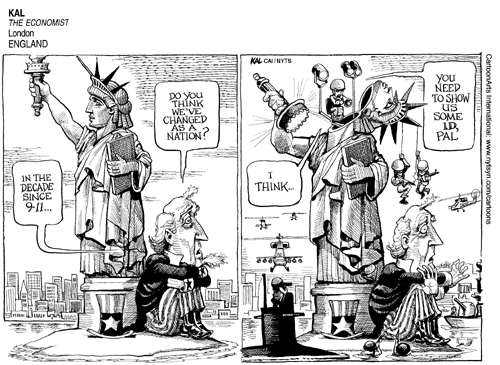Thursday, September 15, 2011
Tuesday, September 6, 2011
Dreams and Nightmares
I've recently written a very long paper on Australian-Asian relations called Dreams and Nightmares: Australia's Past, Present and Future in Asia. It was written for the Institut français des relations internationales (it's in English).
Monday, September 5, 2011
China's Steel Industry
A Reserve Bank of Australia paper from 2010 by James Holloway, Ivan Roberts and Anthony Rush on China's steel industry makes interesting reading in the light of the problems of the Australian steel industry.
Some of the main points:
Growth has been rapid with the period from the mid-90s to the mid-2000s most significant. Growth fell during the financial crisis and recovered on the back of extensive fiscal stimulus by the Chinese government. My guess is that it will slow over the next few years.
Since the introduction of market-based economic reforms in 1978, the Chinese economy has grown strongly, recording an average annual growth rate of around 10 per cent. Over this period, Chinese steel production has also expanded rapidly, growing at an average annual rate of 7 per cent during the 1980s, 10 per cent during the 1990s and close to 20 per cent in the 2000s (Graph 1).
China's percentage of global production has increased rapidly.
China now accounts for around 45 per cent of global steel production, which is significantly higher than its share of 15 per cent at the start of the decade
The Chinese government has attempted to consolidate the industry increasing the percentage of production by the large state-owned firms.
In 2008, there were more than 660 companies producing crude steel, with thousands of other firms producing finished steel and steel-related products. The top 10 producers accounted for less than 50 per cent of crude steel output, with the next 75 companies accounting for an additional 30 per cent (State Council 2009, CISA 2009). Most of the larger Chinese steel producers are state-owned, while a significant proportion of the smaller producers are private companies. Geographically, the industry is widely dispersed. The coastal provinces account for around 65 per cent of crude steel production, with the concentration of steel production in the north-east of the country partly reflecting proximity to major iron ore mines, particularly in Hebei and Inner Mongolia ...
In July 2005, the National Development and Reform Commission issued a formal policy on steel that sought to spur consolidation by increasing the concentration of steel production among large producers, and to protect the environment by reducing energy consumption and eliminating obsolete production capacity. Targets for industry consolidation through mergers and acquisitions or closures of small- to medium-sized firms were outlined. In June 2010, the State Council updated these targets, announcing that the production share of the 10 largest steelmakers was to rise from 44 per cent in 2009 to 60 per cent by 2015, with a goal of cultivating three to five very large, internationally competitive iron and steel conglomerates (State Council 2010).Steel can produced from iron ore and coking coal or from scrap. In Western countries a good deal - about a half to two-thirds - is produced from scrap. In China it is mostly produced from scratch.
Crude (or unprocessed) steel can be produced either directly from iron ore and coking coal using the blast furnace/basic oxygen converter method, or from scrap steel (and other inputs) using the electric arc furnace method. In the United States and Europe, where the electric arc furnace technology is commonly used, between one-half and two-thirds of steel is produced using scrap. In contrast, in China more than 90 per cent of crude steel is produced by steelworks using blast furnaces and basic oxygen converters (World Steel Association 2010). This reflects difficulties with the supply of electricity in some parts of China and low domestic availability of ferrous scrap, due to relatively low household consumption of steel-intensive manufactures and limited scrap collection and processing systems. The prevalence of the converter method has important implications for resource demand: on average, each tonne of Chinese steel requires around 1.7 tonnes of iron ore and more than half a tonne of coking coal as inputs. This helps explain the significant increase in China's demand for these resources over the past decade.China has significant iron ore reserves but they have lower iron content than ore from Australia (62 per cent), Brazil and India (both 65 per cent). Not only is Chinese ore more expensive to process, but much of it is located "inland in the north and west of China. While steel mills in the north-east are close to major iron ore mining precincts, it is costly to transport ore to steel mills located elsewhere in the country."
Increased iron ore shipments have benefited Australian iron ore producers enormously
Strong demand for steel has seen the imported share of iron ore supply increase from around 10 per cent in the late 1980s to more than 50 per cent currently, although over the past five years China's iron ore output has generally kept pace with growth in steel production. This reflects a number of factors, including the high price of imported iron ore and the temporary downturn in steel demand associated with the global financial crisis. More recently, iron ore imports have remained at a high level, having picked up sharply as the Chinese economy recovered from the downturn in late 2008 and early 2009 aided by the substantial fiscal stimulus, although domestic production has also been strong.
In recent years, more than 80 per cent of China's iron ore imports have come from Australia, Brazil and India. In an effort to diversify supply, Chinese policymakers have encouraged direct investment by Chinese companies in iron ore exploration and iron ore mines abroad. To date, numerous investments have been made in West Africa, South America, Central Asia, Russia, Australia and Canada, many of which are large in scale. While efforts to diversify supply may have implications for the Chinese steel industry's sourcing of raw materials in the future, the likelihood of continued high rates of economic growth suggests that China's imports of raw materials will remain high.China has also become more dependent on coking coal imports.
[I]n the first half of 2009, coking coal imports surged, with a pronounced effect on Australian coking coal exports to China. This surge reflected a combination of factors, including a strong rise in steel production, a significant decline in international freight rates, and lower Chinese production of coal owing to efforts to consolidate the coal sector and mine closures or renovations for safety reasons. While China has extensive reserves of coking coal, many of its existing deposits are relatively inaccessible and therefore costly to mine. Many of these deposits are also far from major steel-producing areas.Steel is mainly used in the development of buildings, structures and machinery, with the construction industry accounting for "more than one-half of steel consumption".
Worryingly for steel exporters, China's steel exports have increased since 2006, although they have varied.
Since 2006, China has been a net exporter of steel products. The early 2000s saw a large increase in steelmaking capacity, partly reflecting an increase in the number of small- and medium-sized firms; this growth in capacity translated into higher production, some of which flowed onto the international market. Since China's accession to the World Trade Organization in 2001, the volume of steel exports has increased noticeably; however, steel exports have not recorded sustained growth, and over the past few years have been declining as a share of total domestic production. At times when steel production has risen faster than domestic demand for steel, such as during the 2008 slowdown, China's steel exports have surged, only to decline again when domestic demand for steel has recovered, as was the case during 2009.
Note that these are net exports, China still imports higher quality steel from abroad.
There may be continuing opportunities for developed countries to push their credentials for higher quality steel products. The Australian government could assist the industry especially for steel use within Australia by insisting on rigorous quality testing for imported steel and for restricting contracts that lock out Australian producers. But protecting the industry by tariffs or insisting that projects must use a quota of Australian steel would be a backward step for the Australian economy.
Zealous economic liberals pronounce any suggestion that governments should assist industries as closet protectionism and ironically put their faith in the Chinese Communist Party to keep the Chinese economy growing at 10 per cent or so until the 2030s, I have less faith.
The CCP will need to rebalance the Chinese economy away from excessive investment and when the inevitable adjustment occurs the Australian resource sector will be negatively affected.
Australia needs to debate continuing economic vulnerabilities and consider the potential problems of a less diverse, resource dependent economy.
Subscribe to:
Posts (Atom)

































